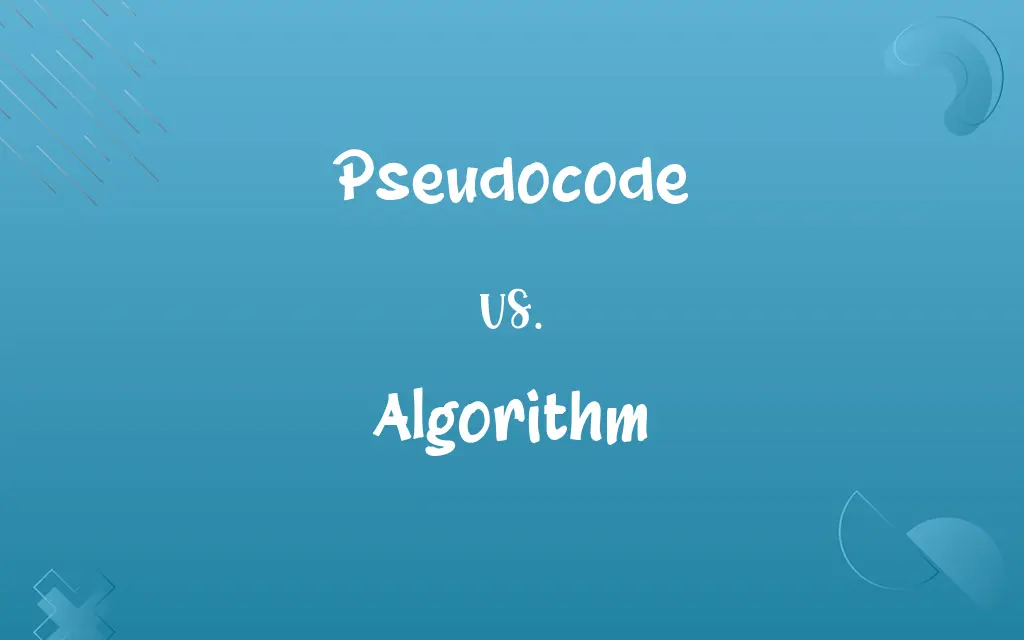Pseudocode vs. Algorithm: Know the Difference

By Shumaila Saeed || Published on January 25, 2024
An algorithm is a set of step-by-step instructions to solve a problem, while pseudocode is a non-technical, informal way of writing those instructions, resembling programming language.

Key Differences
An algorithm is a well-defined procedure or set of rules that outlines how to solve a problem. Pseudocode, on the other hand, is a method for translating an algorithm into a readable and understandable format that resembles programming language.
Shumaila Saeed
Jan 25, 2024
While an algorithm can be expressed in many forms, including natural language or flowcharts, pseudocode is specifically written to mimic code structure without adhering to the syntax of any particular language.
Shumaila Saeed
Jan 25, 2024
Algorithms focus on the logic of the solution, providing a sequence of steps or operations. Pseudocode, while illustrating these steps, uses a more informal and accessible language.
Shumaila Saeed
Jan 25, 2024
An algorithm's primary goal is to provide a clear and unambiguous path to a solution. Pseudocode serves to bridge the gap between an algorithm's conceptual understanding and its implementation in code.
Shumaila Saeed
Jan 25, 2024
Algorithms can be complex and technical, making them challenging for non-experts to understand. Pseudocode simplifies this complexity by stripping away technical jargon and programming-specific details.
Shumaila Saeed
Jan 25, 2024
ADVERTISEMENT
Comparison Chart
Definition
Non-technical way of describing an algorithm.
A set of step-by-step instructions to solve a problem.
Shumaila Saeed
Jan 25, 2024
Purpose
To simplify the understanding of the algorithm.
To provide a clear method for solving a specific issue.
Shumaila Saeed
Jan 25, 2024
Format
Resembles code structure but is language-agnostic.
Can be expressed in natural language, flowcharts, etc.
Shumaila Saeed
Jan 25, 2024
Audience
Intended for both technical and non-technical readers.
Often requires technical or domain-specific knowledge.
Shumaila Saeed
Jan 25, 2024
Detail Level
General outline without deep technical details.
Detailed and precise, covering all logical steps.
Shumaila Saeed
Jan 25, 2024
ADVERTISEMENT
Pseudocode and Algorithm Definitions
Pseudocode
Pseudocode is an informal high-level description of a computer program or algorithm.
In the pseudocode, we first initialize the sum variable to zero.
Shumaila Saeed
Jan 02, 2024
Algorithm
An algorithm can be a set of rules to be followed in problem-solving operations.
Their new search algorithm improved the accuracy of results.
Shumaila Saeed
Jan 02, 2024
Pseudocode
Pseudocode is a tool for planning and discussing algorithms.
We used pseudocode during the meeting to outline the program's flow.
Shumaila Saeed
Jan 02, 2024
Algorithm
An algorithm is a set of instructions designed to perform a specific task.
The algorithm efficiently sorted the list of numbers.
Shumaila Saeed
Jan 02, 2024
Pseudocode
Pseudocode is used to express algorithms in a readable and understandable manner.
Her pseudocode clearly showed how the sorting algorithm would work.
Shumaila Saeed
Jan 02, 2024
ADVERTISEMENT
Algorithm
An algorithm is a step-by-step procedure for calculations.
She explained the algorithm for solving linear equations.
Shumaila Saeed
Jan 02, 2024
Pseudocode
Pseudocode bridges the gap between problem-solving ideas and actual coding.
Before writing the code, he drafted the main logic in pseudocode.
Shumaila Saeed
Jan 02, 2024
Algorithm
An algorithm is a method or a formula for solving a problem.
The algorithm he developed optimized the network's performance.
Shumaila Saeed
Jan 02, 2024
Pseudocode
Pseudocode is written in a style resembling programming, but without strict syntax.
The pseudocode included a 'for loop' to iterate over each item.
Shumaila Saeed
Jan 02, 2024
Algorithm
An algorithm is a series of steps to achieve a particular outcome.
The cooking recipe is similar to an algorithm with specific steps.
Shumaila Saeed
Jan 02, 2024
Pseudocode
(computing) A description of a computer programming algorithm that uses the structural conventions of programming languages but omits detailed subroutines or language-specific syntax.
Shumaila Saeed
Jan 02, 2024
Algorithm
A finite set of unambiguous instructions that, given some set of initial conditions, can be performed in a prescribed sequence to achieve a certain goal and that has a recognizable set of end conditions.
Shumaila Saeed
Jan 02, 2024
Algorithm
(countable) A collection of ordered steps that solve a mathematical problem. A precise step-by-step plan for a computational procedure that possibly begins with an input value and yields an output value in a finite number of steps.
Shumaila Saeed
Jan 02, 2024
Algorithm
A precise rule (or set of rules) specifying how to solve some problem; a set of procedures guaranteed to find the solution to a problem.
Shumaila Saeed
Jan 02, 2024
Algorithm
A precise rule (or set of rules) specifying how to solve some problem
Shumaila Saeed
Jan 02, 2024
Repeatedly Asked Queries
What is pseudocode?
Pseudocode is an informal way of writing algorithm steps in a language-like format.
Shumaila Saeed
Jan 25, 2024
What is an algorithm?
An algorithm is a set of instructions or steps to solve a problem or perform a task.
Shumaila Saeed
Jan 25, 2024
Are algorithms always written in code?
No, algorithms can be written in various forms, including natural language and pseudocode.
Shumaila Saeed
Jan 25, 2024
Do you need programming knowledge to write pseudocode?
Not necessarily, as pseudocode is meant to be understandable even without programming experience.
Shumaila Saeed
Jan 25, 2024
What’s the main purpose of pseudocode?
To simplify the understanding of an algorithm, making it easier to translate into code.
Shumaila Saeed
Jan 25, 2024
Can algorithms be used in non-computing contexts?
Yes, algorithms can be applied in many fields, not just computing.
Shumaila Saeed
Jan 25, 2024
Do algorithms need to be efficient?
Ideally, yes, efficiency in terms of time and resources is important in algorithms.
Shumaila Saeed
Jan 25, 2024
How detailed should an algorithm be?
An algorithm should be detailed enough to cover all steps and scenarios.
Shumaila Saeed
Jan 25, 2024
Is pseudocode a programming language?
No, it's a simplified representation of code, not a language itself.
Shumaila Saeed
Jan 25, 2024
Are there standard rules for writing pseudocode?
There are no strict rules, but common conventions exist for clarity.
Shumaila Saeed
Jan 25, 2024
What makes a good algorithm?
Clarity, efficiency, and correctness are traits of a good algorithm.
Shumaila Saeed
Jan 25, 2024
Why is pseudocode not executable?
Because it lacks the precise syntax required for execution by a computer.
Shumaila Saeed
Jan 25, 2024
Can pseudocode be converted directly into code?
It cannot be converted directly but serves as a guide for writing actual code.
Shumaila Saeed
Jan 25, 2024
Is pseudocode useful for experienced coders?
Yes, it’s useful for outlining and discussing complex logic.
Shumaila Saeed
Jan 25, 2024
Can one problem have multiple algorithms?
Yes, there can be several approaches (algorithms) to solve a particular problem.
Shumaila Saeed
Jan 25, 2024
Can pseudocode vary in format?
Yes, it can vary based on personal style or team conventions.
Shumaila Saeed
Jan 25, 2024
Do all programmers use pseudocode?
Not all, but many use it for planning and communicating complex logic.
Shumaila Saeed
Jan 25, 2024
Can pseudocode help in debugging?
Yes, it can help conceptualize the logic and identify potential issues.
Shumaila Saeed
Jan 25, 2024
Does an algorithm dictate a specific programming language?
No, algorithms are independent of programming languages.
Shumaila Saeed
Jan 25, 2024
Are algorithms limited to specific types of problems?
No, they can be designed for a wide range of problems.
Shumaila Saeed
Jan 25, 2024
Share this page
Link for your blog / website
HTML
Link to share via messenger
About Author
Written by
Shumaila SaeedShumaila Saeed, an expert content creator with 6 years of experience, specializes in distilling complex topics into easily digestible comparisons, shining a light on the nuances that both inform and educate readers with clarity and accuracy.








































































